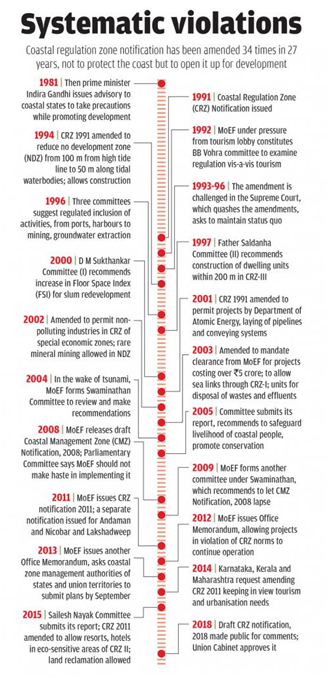

Supreme Court has ordered the demolition of Maradu Apartments in Kerala for violation Coastal Regulation Zone (CRZ) norms.
Context
Supreme Court has ordered the demolition of Maradu Apartments in Kerala for violation Coastal Regulation Zone (CRZ) norms.
About
- Under the Environment Protection Act, 1986 Ministry of Environment and Forests (MoEF) issued notification in 1991, for regulation of activities in the coastal area.
- Coastal Regulation Zone (CRZ) is the area up to 500m from the high-tide line and a stage of 100m along banks of creeks, estuaries, backwater and rivers subject to tidal fluctuations.
- CRZ Rules govern human and industrial activity close to the coastline, in order to protect the fragile ecosystems near the sea.
- The Union Ministry of Environment, Forest and Climate Change has notified the 2019 Coastal Regulation Zone (CRZ) norms, replacing the existing CRZ norms of 2011.
- The new CRZ norms aim to promote sustainable development based on scientific principles.
- Coastal Regulation Zones (CRZ) 1991 notification gave four fold classifications of coastal areas.
- CRZ-1: These are ecologically sensitive areas as they help in maintaining the ecosystem of the coast. They lie between low and high tide line. Exploration of natural gas and extraction of salt are permitted
- CRZ-2: These areas are urban areas located in the coastal areas. Now under new coastal zone regulations 2018, the floor space index norms have been de-freezed.
- CRZ-3: rural and urban localities which fall outside the 1 and 2. Only certain activities related to agriculture even some public facilities are allowed in this zone
- CRZ-4: this lies in the aquatic area up to territorial limits. Fishing and allied activities are permitted in this zone. Solid waste should be let off in this zone. This zone has been changed from 1991 notification, which covered coastal stretches in islands of Andaman & Nicobar and Lakshdweep
Changes Brought about by CRZ Regulations 2019
States found the 1991 Rules to be extremely restrictive. They complained that if applied strictly, the Rules would not allow simple things like building decent homes for people living close to the coast, and carrying out basic developmental works 2019 CRZ notification brought following changes:
- Two separate categories for CRZ-III (Rural) areas:
- CRZ-III A: The A category of CRZ-III areas are densely populated rural areas with a population density of 2161 per square kilometre as per 2011 Census. Such areas have a No Development Zone (NDZ) of 50 meters from the High Tide Line (HTL) as against 200 meters from the High Tide Line stipulated in the CRZ Notification, 2011.
- CRZ-III B – The B category of CRZ-III rural areas have population density of below 2161 per square kilometre as per 2011 Census. Such areas have a No Development Zone of 200 meters from the HTL.
- No-development zone of 20 m for all islands close to the mainland coast, and for all backwater islands in the mainland.
- The government has decided to de-freeze the Floor Space Index and permit FSI for construction projects to do away with CRZ 2011 notification
- Tourism infrastructure like shacks, toilet blocks, change rooms, drinking water facilities, etc. permitted in coastal areas: The new norms permit temporary tourism facilities such in Beaches.
- To address pollution in Coastal areas, the treatment facilities have been made permissible in CRZ-I B area subject to necessary safeguards.
Criticism
- CRZ notification has been amended 34 times in 27 years, not to protect the coast but to open it up for development.
- Though exemption was made for the construction of the Navi Mumbai airport but the POSCO project had failed to take off due to other reasons. Projects of the Department of Atomic Energy, which plans to set up nuclear power plants near the coast, were also exempted which have serious environmental implication as we leant from the Fakushima nuclear disaster 2011.
- Large scale construction in CRZ has huge implications on Environment.
Conclusion
A balanced approach to achieve developmental goals without hurting the environment should be the policy push.

